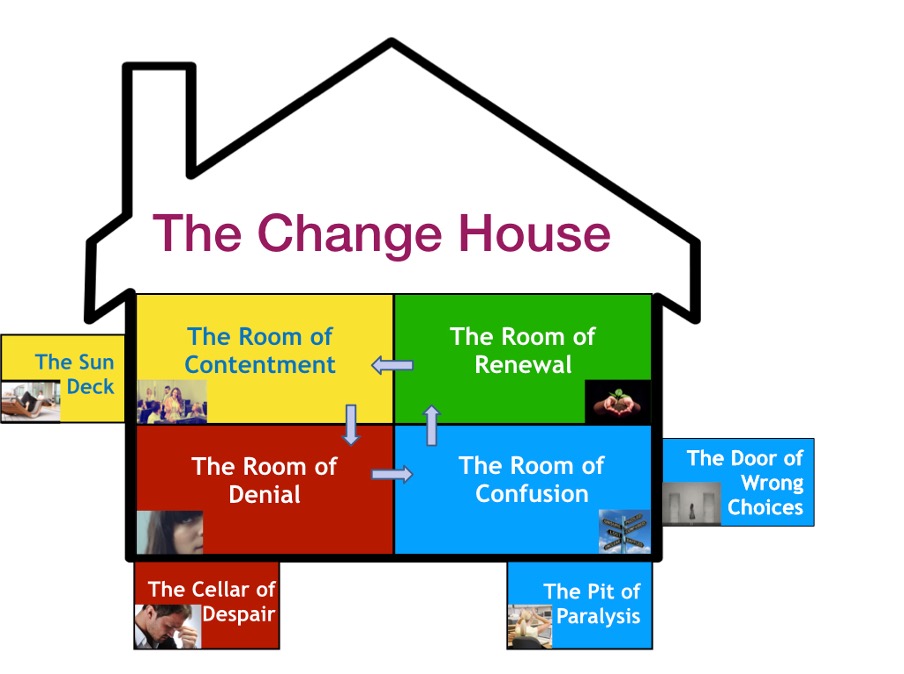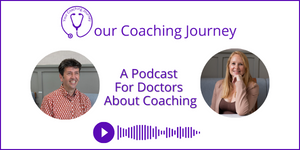Prefer to listen?
This blog post forms the basis of a podcast on our new coaching model, which you can listen to here.
We believe that most people come to coaching because there’s something they want to change in their lives.
Although traditionally, coaching was all about goals, which you could potentially say, is about something changing, within our coaching, we both recognise that quite often people without a big goal, as such, but either because something has changed or because there’s some change that they want to bring about.
If someone comes to coaching because things have changed around them, so it’s an extrinsic change. and they can find that problematic. We can do good work in the coaching room just helping them to get some perspective on the change that’s happening.
It would usually be about this time that some coaches would roll out the Kübler-Ross change curve, which we will simply refer to as the change curve. To find out why, you may want to read our article ‘Kübler-Ross Never Had A Change Curve’
Having an awareness of the stages of change in the Change Curve model would be useful, just as a bit of a framework to understand why they, or others might be struggling with the change. Recognising that there are those different stages, such as denial, anger, maybe some sadness, then moving through the sadness to get to looking at the future.
And that’s what coaching is all about. It’s focusing on the future and what are you going to do as a result? What would you like to have happen?
When it comes to change, it is useful to recognise that there will be some emotion attached to it and some different emotional responses that people go through. But overall, people do acclimatise to the new reality. So that’s also useful to recognise. As coaches, we can do good work just in reassuring someone that these are quite normal emotions to feel when going through change. Not as glib as ‘this too shall pass’, but recognising that it is a stage to go through and that hopefully things will improve.
So we can help with:
- normalising the emotional reaction to change for people
- some perspective taking
- recognising why the change is happening from the organisational perspective,
- what it means for the people around them,
- how they might reframe it more positively
There’s a lovely bit in a George Clooney film, Up in the Air, where he’s responsible for getting rid of people. The company is making people redundant, bringing him in, and he has to have the conversation and tell them they’re being let go. There’s a lovely scene where he’s talking to someone and saying, ‘How much did they pay you to give up on your dreams?’
Followed by something like: ‘You were a chef. You studied French cuisine. Then you ended up pushing paper around in this organisation for the last 20 years. At what point did you just give up on those dreams? How would your children feel if you went back to being a chef?’
Obviously, it’s a movie, it’s scripted. But there was something about, that realisation that this isn’t what he wanted to do with his life and here’s an opportunity to do something different. Change is happening, but he could make something of that change.
Quite often when people come for coaching there is some big change happening. This is often a great opportunity to think about what’s important in your life, to reconnect with your values, and actually to think, What do I want to do with the time I have left in my life?, What’s the new direction for me? And to find some new perspective and to explore possibilities.
Coaching is a lovely space to do that.
One side of change is definitely coming to terms with that change. Aother side of change is where a client want something to change. They might not recognise that it is change at the outset. They might see it a problem that need’s fixing. But if we think about the coaching model we use, TOM’S CODE, after we’ve looked at the situation, and they’ve told us all about what the problem is, then we ask, ‘What would you like to have happen?’ That’s where we get to the change that they want to see.
And that gives them the thing to work towards.
Change isn’t easy. Certainly, if it’s being done to you, there’s a degree to which you have to work to accept it. If you’re wanting to bring about change, then the work is around what you actually want to have happen, and then the steps that you’re going to take, the options you’ve got in order to make that happen, and then the steps you’re going to take to move forward on it.
Really defining what that change looks like as well as how you’re going to get there.
The Change House
The Change House is a model designed by a Swedish psychologist, Claes Janssen, that looks at the different rooms that we might be in when change happens.

The first room that he has people sitting in is the room of contentment; if you’re happy with your job and you’re happy with life, then you might be sitting in that room.
One of the nice little add-ons to the room of contentment is the sun deck, which is like being too contented. You’re just cruising and you’re out on the sun deck, not really working at any self-development or growth or anything.
And then some change happens.
You might then move to the room of denial. This is where people are just denying the change is happening or is ever going to happen. If we spend too long in the room of denial, (because we know it’s going to happen, really, it is just we’re can’t quite get our head around it)
we can end up in the cellar of despair.
We move from the room of contentment to the room of denial and perhaps the cellar of despair because we’re not moving on in our thinking.
Then we might come to the room of confusion: We’re accepting that change is happening. If we think perhaps of organisational change, we’ve been told that, now we’re doing things a different way. We might not know how it’s going to work, so there might be some talk about that.
But you might get into the pit of paralysis. If you’re stuck in the pit of paralysis, then the change isn’t actually happening, but we’re not getting what we want either.
Or we might go through the door of wrong choices, going, Well, this is a waste of time. We’re not doing this.
Let’s go back to where we were in the room of contentment and just go full circle.
So nothing has really changed. But obviously, something needs to change. So that’s not the best place to be.
Eventually we get to the room of renewal.
From an organisational perspective, people would want to end up, and the organisation would want you to end up in the room of renewal.
If we get to the room of renewal, things have changed, we get used to the new way of being, then potentially we end up back in the room of contentment and might need something to change.
If we think about the GB cycling team, they have that ethos of continuous improvement, incremental change, trying to make things ever so slightly better than they were before. If we stick in the room of contentment, then there is no change.
We don’t want to end up in the room of denial, but I think that idea that change is constant and that it’s not something to be afraid of is a great way of thinking about life. Yeah, I think so.
Paradoxical Change
We talk in Gestalt coaching about paradoxical change.
Change is happening all around us. When we record our podcast, we will leave that space with something having changed for both of us. As you’re reading this, your awareness of change and your thinking around change will have altered in some way.
But perhaps change is happening in a way that we don’t intend. If we’re pushing for change, quite often what happens, isn’t exactly what we want.
Maybe (according to the gestalt approach), the best way to think about change is to think about becoming more who you are and doing more of the things that you love. Then change will happen automatically. It will just happen. It will just emerge.
In coaching, that’s something that we try to have in mind; by having the conversation and talking through change with someone, change will start to emerge anyway. We don’t need to be trying. We don’t need to try to be something we’re not in order to change.
We don’t need to be pushing at a door. It might be the door of wrong choices. Or it might be that we’re being asked to change to be how someone else wants us to be, which is not a great place to be either.
What coaching is brilliant for is helping people to become more of themselves, more of who they truly are, and therefore, change is inevitable. Or rather, a metamorphosis in to becoming more you!
It’s about us behaving in a more authentic way. And a lot of the coaching that we do is around people being authentic and showing up in a more authentic way – becoming more themselves. Or perhap, remembering who you are and remembering who you wanted to be. This can be really transformational.
People being who they truly are and not changing, allows different, more authentic change to emerge.
Hence the term paradoxical change.
So that’s the start of our journey through change. We hope you have enjoyed it, and we’re sure we will return to it in future articles.
The Gestalt Approach and changing habits and behaviours are covered in detail on both our Doctors’ Transformational Coaching Diploma and our Transformational Coaching DIploma for Lifestyle Medicine.



